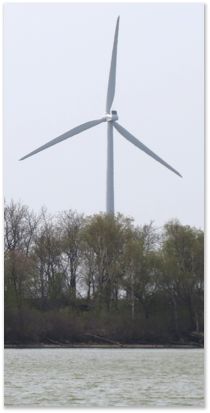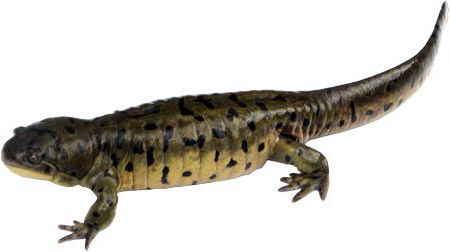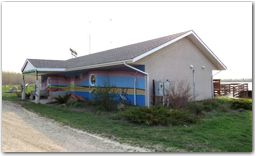
Tigers and Turbines: St Léon's unique interpretive centre.
| By Doug Collicutt | A NatureNorth Note |
Introduction
St Léon is a small town in southern Manitoba with a big interest in tigers and turbines: "tiger" salamanders and wind "turbines" that is. And that interest in these cool amphibians and the sustainable energy source of a wind farm is on display at the Saint Léon Interpretive Centre.
I had the pleasure of visiting the centre for a meeting with some regional biologists with Manitoba Sustainable Development (formerly Manitoba Conservation) and some folks from Brandon University interested in developing a citizen-science project relating to the Barred Tiger Salamanders (Ambystoma mavortium) that inhabit this region. NatureNorth runs the Manitoba Herps Atlas project to collect new location records for reptiles and amphibians in this province, so getting involved with this was a no-brainer.

Wind Power!
I'd never been to St Léon before, but I had driven by the wind farm that's set up around the town. There are 73 turbines in the area surrounding the town. Each one consists of an 80 m pole atop of which sits the generator/turbine with its three 40 m long blades. The tip of each blade at the top of its sweep is 120 m above the ground! (Get more turbine facts from St Léon's own website.) St Léon is justifiably proud of its "wind farm" that generates 120 Megawatts of clean electric energy.
|
Salamander Power!
St Léon has always been proud of its tiger salamanders which thrive in the small pothole lakes in the region. The Interpretive Centre was established to help people learn about the salamanders and the importance of wetlands in general to the preservation of Manitoba's biodiversity and the protection of our environment. With the advent of the wind farm, and its 73 giant "windmills", information about this clean energy production was added to the centre.

Basic Salamander Biology
Tiger salamanders start life in a jelly coated egg laid in the water. Adult females and males move to ponds and small lakes in early spring, often before all the ice is gone. They mate and the females lay masses of eggs on the stalks of aquatic plants. After several weeks the eggs hatch and the tiny larvae begin to swim around and hunt for food. They eat tiny aquatic invertebrates. As young larvae they have no legs, just a body with a powerful finned tail, feathery external gills, large well-developed eyes and a strong mouth. Front legs develop after a few weeks, back legs develop later. By the end of August or early September, if the larvae have grown large enough they will transform to their adult form, losing their gills and tail fin, and leave the water to become terrestrial salamanders. Sometimes they overwinter in the ponds and transform the following year.
Adult salamanders are largely fossorial; that is they live in underground burrows or dig through soft soils. They likely only venture above ground at night or during wet weather. The adults feed on worms, insects or even small vertebrates, like frogs or smaller salamanders. They spend winter in burrows down below the frost line.
|
There are lots of anecdotal tales of huge numbers of tiger salamanders crossing roads as they leave the ponds for their life on land in late summer. Sadly though, it seems that huge numbers of salamanders are seen less and less often. Are overall populations in decline? Are changes in the environment affecting salamander numbers? These are questions that need answering. I hope our governments are taking note and I hope that concerned citizens, like those running the St Léon Interpretive Centre will keep up their efforts to promote awareness of Manitoba's natural heritage.
Final Thoughts
St Léon should feel proud of the terrific interpretive centre they have made. I wish more communities would take notice and make the effort that St Léon has to help teach Manitobans about the importance of taking care of our environment.
Google Map to the St Léon Interpretive Centre.
(The Interpretive Centre address is 35 Baie du Lac, Box 5044, St Léon, Manitoba, R0G 2E0; The Surrey, BC address on the map is a Google Map error that will be corrected shortly.)
Thanks for learning about St Léon's Interpretive Centre! Bye for now!
| You can help NatureNorth produce more great articles with a secure donation through PayPal. Our Google Adsense ads pay our server costs, but that's about it. To learn more follow this link: Support NatureNorth. Thank-you! | |
Return to: Fall Issue | NatureNorth Front page

